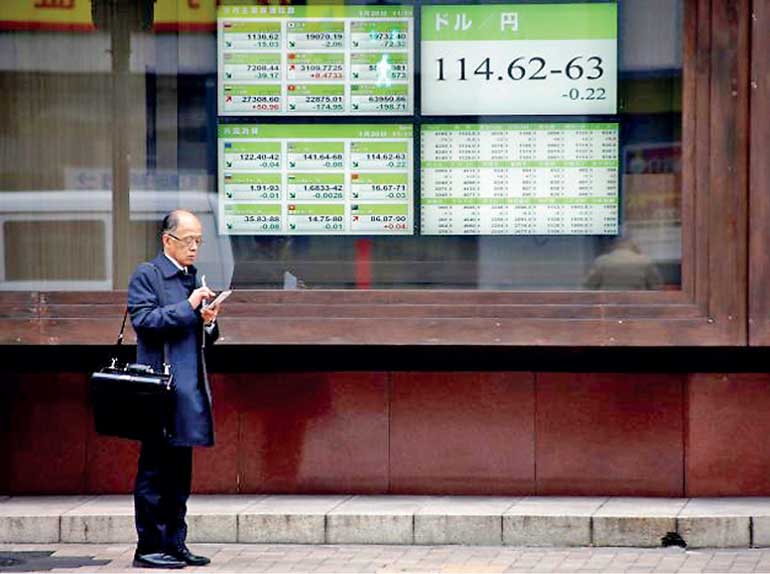Tuesday Feb 11, 2025
Tuesday Feb 11, 2025
Friday, 3 February 2017 00:00 - - {{hitsCtrl.values.hits}}
 Reuters: Asian shares ticked up while the dollar was capped on Thursday after the U.S. Federal Reserve stuck to its mildly upbeat economic view but gave no hint of any immediate rate hike.
Reuters: Asian shares ticked up while the dollar was capped on Thursday after the U.S. Federal Reserve stuck to its mildly upbeat economic view but gave no hint of any immediate rate hike.
While strong economic data from the United States and elsewhere underpinned risk assets, uncertainty and concerns over U.S. President Donald Trump’s policies are leaving markets on edge.
“With many of his cabinet members still not approved, including (incoming Treasury Secretary Steven) Mnuchin, Trump’s occasional remarks and tweets are the only guidance markets can get from the new U.S. administration at the moment,” said Shuji Shirota, head of macro strategy group in Tokyo at HSBC.
“For the time being, markets will continue to be driven by what Trump will say. It’s Trump-on, Trump-off, rather than risk-on, risk-off,” he added.
MSCI’s broadest index of Asia-Pacific shares outside Japan gained 0.2% while Japan’s Nikkei also ticked up 0.05%. On Wall Street, the S&P 500 stabilised after a four-day losing streak, although it would have been in negative territory without a 6.1% rise in Apple following strong earnings. U.S. shares have been hit by worries that Trump’s tough stance on refugees and immigration could stem inflows of talent to the U.S. labour market and raise geopolitical tensions.
On Wednesday the Federal Reserve held interest rates steady in its first meeting since Trump took office.
While painting a relatively upbeat picture of the U.S. economy, its statement gave no firm signal on the timing of its next rate move as Fed policymakers are still awaiting clarity on the possible impact of Trump’s economic policies.
Nor was there any hint on whether it plans to trim its $4.5 trillion balance sheet, an increasingly hot topic among the Fed’s policy circle.
Following the Fed, U.S. interest rate futures pared losses to stand little changed, pricing in two rate hikes this year.
The 10-year U.S. Treasuries yield stepped back to 2.473% from the day’s high of 2.518%.
“We’ve been expecting the Fed’s next rate hike to come in June and there was nothing from the Fed indicating a hike in March,” said HSBC’s Shirota. That dented the dollar, which had been recovering earlier on a raft of solid U.S. economic data, including The Institute for Supply Management’s (ISM) index of manufacturers surging to two-year highs and strong hiring data from ADP National Employment Report.
The euro stood at $1.0764, having bounced back from Wednesday’s low of $1.0730, edging back towards $1.08125, Tuesday’s eight-week high touched after comments from a Trump adviser that Germany is benefitting from a “grossly undervalued” euro.
The dollar traded at 113.28 yen, having slipped from Wednesday’s high of 113.95 yen.
The British pound hit a 1 1/2-month high of $1.2680 on Wednesday as solid UK economic data and greater political certainty over the Brexit process encouraged a trimming of big financial bets against the currency.
The Bank of England, due to issue inflation report later in the day, is expected to stick to a neutral policy stance.
Signs of strong UK growth have financial markets already pricing in a 40% chance of higher official interest rates this year.
The dollar’s index against a basket of six major currencies stood at 99.75, having slipped almost 4% from its 14-year high of 103.82 set on Jan 3.
In commodities, crude oil futures eased after a rally the previous day on geopolitical concerns after Iran confirmed a ballistic missile test and bulls found support in reports on production cuts.
U.S. crude futures dropped 0.6% to $53.53 per barrel, after having climbed 2.0% on Wednesday.
Discover Kapruka, the leading online shopping platform in Sri Lanka, where you can conveniently send Gifts and Flowers to your loved ones for any event including Valentine ’s Day. Explore a wide range of popular Shopping Categories on Kapruka, including Toys, Groceries, Electronics, Birthday Cakes, Fruits, Chocolates, Flower Bouquets, Clothing, Watches, Lingerie, Gift Sets and Jewellery. Also if you’re interested in selling with Kapruka, Partner Central by Kapruka is the best solution to start with. Moreover, through Kapruka Global Shop, you can also enjoy the convenience of purchasing products from renowned platforms like Amazon and eBay and have them delivered to Sri Lanka.
Discover Kapruka, the leading online shopping platform in Sri Lanka, where you can conveniently send Gifts and Flowers to your loved ones for any event including Valentine ’s Day. Explore a wide range of popular Shopping Categories on Kapruka, including Toys, Groceries, Electronics, Birthday Cakes, Fruits, Chocolates, Flower Bouquets, Clothing, Watches, Lingerie, Gift Sets and Jewellery. Also if you’re interested in selling with Kapruka, Partner Central by Kapruka is the best solution to start with. Moreover, through Kapruka Global Shop, you can also enjoy the convenience of purchasing products from renowned platforms like Amazon and eBay and have them delivered to Sri Lanka.